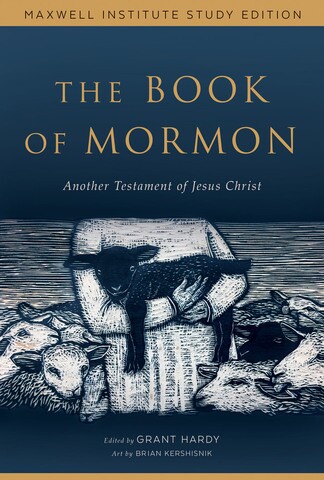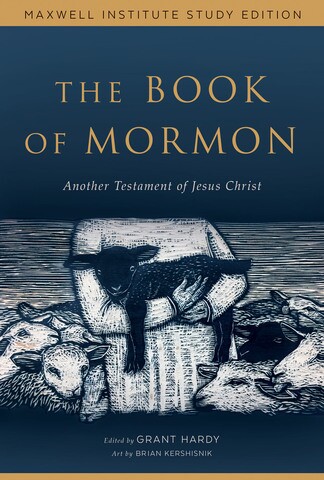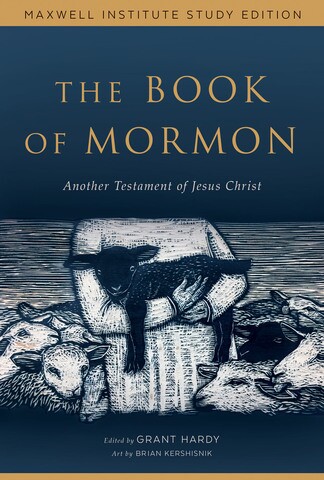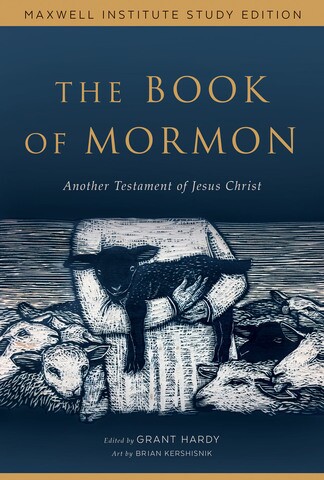Reading the scriptures can be an incredible experience, but sometimes small things like reading a certain number of verses per day or repeatedly seeing the same layout get in the way. A new book from the Neal A. Maxwell Institute of Religious Studies at BYU hopes to eliminate any obstacles posed by the layout of the text.
The Book of Mormon: Another Testament of Jesus Christ, Maxwell Institute Study Edition presents the official text of the Latter-day Saint scripture in a way that mirrors contemporary study bibles — but without changing any words.

The new book received permission from The Church of Jesus Christ of Latter-day Saints to use the 2013 copyrighted text of the Book of Mormon, but it is not an official church publication.
“The Study Edition does not replace the official version of scripture in any way,” explained Spencer Fluhman, director of the Maxwell Institute, in an email interview. “Rather, it seeks to complement study for serious students.”
The layout changes are easily distinguishable from the official Book of Mormon printed by the church. For example, verses are portrayed in a single-column paragraph form, section headings provide a quick glimpse into what is taking place in the book’s narrative, and poetic passages are reset in poetic lines.
According to Grant Hardy, the book’s editor, these changes follow a pattern of infrequent but dramatic changes to the layout of scriptures over time.
The Book of Mormon’s original typesetter, John Gilbert, set the stage for many successive changes in the original 1830 edition, which was originally published in paragraphs.
“He appears to have used ‘and it came to pass’ as a paragraph marker,” wrote Hardy, in an email interview. “Some of the paragraphs are quite long, sometimes continuing over several pages.”
Hardy explains another significant change was made in 1879 when the text was divided into shorter chapters and verses. “These innovations made it easier to locate particular passages,” he said, “but they also tended to break up the flow of the narrative and the rhetorical coherence of the sermons.”
Other critical changes occurred in the 20th century and included the creation of double columns, chapter headings and cross-references in the footnotes.
The Study Edition also contains footnotes, but of a different variety than readers are used to.
“I highlighted the structure and literary patterns inherent in the text that can be difficult to perceive in a verse-by-verse format,” said Hardy. “Most importantly, I included footnotes drawn from Royal Skousen’s groundbreaking work.”
Skousen is a professor of linguistics at BYU who has spent years analyzing both the original manuscript and printer’s manuscript of the Book of Mormon. His published research amounts to more than 4,000 pages and painstakingly analyzes every change to the text.
Hardy has sorted through Skousen’s voluminous research and picked out the changes of most relevance to modern readers.
“I’ve included nearly 200 readings from the original manuscript and another 200 from the printer’s manuscript,” said Hardy. “I tried carefully to select those findings of his that would make the most difference for contemporary readers of the 2013 text.”
In an episode of the Latter-day Saint Perspectives podcast, Hardy explains there are times when Skousen’s research illuminates the text. For example, early editions of the Book of Mormon have Alma telling his wayward son Corianton to “retain” instead of “repair” his sins because an inkblot made the “p” look like a “t” when Oliver Cowdery was copying the manuscript.
“In this case, it actually brings back a superior reading,” said Hardy in the podcast.
Hardy also pays close attention to portions of the 1830 layout that were actually part of the source material used by Joseph Smith.
“In the text of the Study Edition, I emphasized the original 1830 chapter breaks (which were part of the gold plates),” Hardy wrote in his email interview, “and used boldface type to indicate places where Nephite writers used phrases from scripture they had just quoted.”
Hardy also places text in bold in which prominent bible authors such as Isaiah and Matthew are quoted differently in the Book of Mormon.
“This is one of the ways the Book of Mormon functions as a sort of biblical commentary,” said Hardy.
As a literary scholar, Hardy has published previous works on the Book of Mormon. He published an edition of the Book of Mormon in 2003 titled The Book of Mormon: A Reader’s Edition, published by the University of Illinois Press, intended for academics, and a study of Book of Mormon narrative in 2010 titled Understanding the Book of Mormon: A Reader’s Guide, published by the Oxford University Press, intended for both Latter-day Saints and scholars of other faiths.
The Maxwell Institute Study Edition differs from both of these previous publications because of its target audience.
“This edition was conceived with ‘disciple-scholars’ in mind,” said Fluhman. “In other words, it resonates with faithful scholarship from an array of researchers and writers but is intended … for those who regard the text as revealed scripture.”
Kurt Manwaring is freelance writer and contributor to the Deseret News. He is online at fromthedesk.org.




